This article was written by Gayle Geber, Benedict G. Fischer’s Granddaughter, October, 2011
Benedict G. Fischer, St. Paul Police Patrolman
Part IV – Shooting, Hospitalization, and Arrests
August 6, 1917
Minneapolis, Minnesota
Armed with two revolvers, Heinbaugh, Harris, and Warren arrive in Minneapolis and immediately begin their nearly week-long crime spree, robbing people every night. After about three or four days they go to St. Paul and continue holding up people. Heinbaugh and Harris are armed, but they haven’t fired any shots. Warren’s job, without a weapon, is taking money and objects of value from the victims. They confine these nighttime activities to the St. Anthony Hill residential district just up the hill from the St. Paul Cathedral. This string of robberies is occurring with such regularity that the police are stationing officers on the streetcar lines these men are likely to use to escape toward Minneapolis.
 August 11, 1917, just after midnight
August 11, 1917, just after midnight
St. Paul, Minnesota
It is a beautiful night but a cool one for summer in Minnesota. Ben Fischer, proudly displaying badge 158, is walking his beat and stops each hour at the call box to contact the Rondo station and see if he’s needed anywhere. This time he is informed that there have been more hold-ups in the vicinity. H. H. Campbell was robbed at Carroll Street and Western Avenue. John Auger, who lives on Summit Avenue, was also robbed nearby. Ben and his partner, Wylly Smallwood (a tall man with a stout build), head east to meet up with Mr. Campbell near his home on Oxford Street. They soon learn that he can identify the suspects. They commandeer a private car, grab Mr. Campbell, and speed off to search for the robbers with Ben standing on the running board and gripping the car through the open window.
There are few streetcars running at 2 o’clock in the morning, even on the well-traveled University Avenue line. At the intersection of University and Dale, Mr. Campbell spots at least one of the three robbers on the streetcar heading west toward Minneapolis. Campbell alerts the two officers. They stop the streetcar. Talking to the motorman just outside his entrance at the front of the streetcar, Ben and officer Smallwood briefly discuss what to do. Ben boards the streetcar through the small front entrance. Officer Smallwood remains outside.
 Entering the streetcar, Ben quickly scans the passengers in the front,
but he does not recognize Warren. As he scrutinizes the passengers, all
of whom are facing him, he thinks he recognizes Harris on the right side
of the car. Ben steadily walks down the aisle and turns slightly to put
his right hand on Harris’ shoulder. Harris, who is seated with his
arms crossed over his chest hiding his weapon, immediately withdraws his
gun and shoots Ben point blank. The bullet rips into his neck behind his
ear and he immediately drops to the floor. As Ben is lying crumpled on
the floor of the narrow aisle before he loses consciousness, he thinks, “Why
are they pouring water into my mouth?” (It’s days later that
he learns it was blood from the gunshot wound that was spurting into his
mouth.) Heinbaugh immediately joins Harris in the fire fight, as Harris
scrambles over Ben’s body to get to the large passenger exit at the
rear of the car. One of the passengers, Gust Marchessault, is so close
to one of the shooters that his right arm is singed by the blaze from the
pistol.
Entering the streetcar, Ben quickly scans the passengers in the front,
but he does not recognize Warren. As he scrutinizes the passengers, all
of whom are facing him, he thinks he recognizes Harris on the right side
of the car. Ben steadily walks down the aisle and turns slightly to put
his right hand on Harris’ shoulder. Harris, who is seated with his
arms crossed over his chest hiding his weapon, immediately withdraws his
gun and shoots Ben point blank. The bullet rips into his neck behind his
ear and he immediately drops to the floor. As Ben is lying crumpled on
the floor of the narrow aisle before he loses consciousness, he thinks, “Why
are they pouring water into my mouth?” (It’s days later that
he learns it was blood from the gunshot wound that was spurting into his
mouth.) Heinbaugh immediately joins Harris in the fire fight, as Harris
scrambles over Ben’s body to get to the large passenger exit at the
rear of the car. One of the passengers, Gust Marchessault, is so close
to one of the shooters that his right arm is singed by the blaze from the
pistol.
Outside, as he takes cover behind a telephone pole, officer Smallwood pulls his Smith and Wesson from his back pants pocket and returns fire. Streetcar windows shatter. Heinbaugh and Harris continue shooting in the direction of officer Smallwood. The few passengers on the streetcar panic and duck behind their seats as the bullets fly. Harris’ ankle is grazed by a bullet, but it doesn’t stop him. Officer Smallwood sustains a minor injury but, nonetheless, shoots Warren in the earlobe before his police pistol jams. Warren then hides behind his seat.
This lull in officer Smallwood’s firing allows the suspects to begin their escape. Heinbaugh and Harris jump down eight inches to the streetcar platform and from here clamber desperately over the five-foot-tall gates, landing awkwardly in the street. Getting back on their feet, they flee east down University. Warren remains on the streetcar and hides behind the seats.
Less than a minute after his gun jams, officer Smallwood is joined by patrolmen Joseph Falkey (a highly decorated marine from the Spanish American War), Ernest Heere, and William Lancette from the Rondo Station. One of these officers calls for an ambulance on the call box. At Rondo Station, someone calls City Hospital to tell them a gunshot victim is on his way.
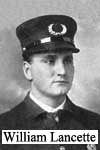 Meanwhile, Sergeant William Lancette tackles Warren when he attempts to
crawl out a window of the streetcar. Sergeant Lancette subdues and arrests
him. Warren – slightly wounded in the arm and ear, but with his face
severely battered – is the only one taken into custody at the scene.
Meanwhile, Sergeant William Lancette tackles Warren when he attempts to
crawl out a window of the streetcar. Sergeant Lancette subdues and arrests
him. Warren – slightly wounded in the arm and ear, but with his face
severely battered – is the only one taken into custody at the scene.
Although Heinbaugh and Harris are still in the area – just a half block east of Dale on University – police don’t catch sight of them in the pitch-black darkness. The two men count on the cover of darkness to elude the police. They lean tight into the shadows of a building, pausing for a few seconds to reload their cheap, but efficient, long-barreled weapon with .38 caliber shells. The two suspects then turn right on Kent Street and run about a half mile to Selby Avenue. They catch another streetcar heading west on the Selby-Lake line toward Minneapolis.
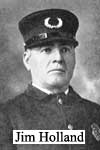 The police motor ambulance, operated by officer Jim Holland, finally arrives.
The crew deftly lifts Ben onto the stretcher, loads their critically injured
brother into the ambulance, and rushes him to City Hospital about three
miles south, traveling at amazing speeds of up to 20 miles per hour. With
little equipment to assist him, the doctor on board does his best to stanch
the blood flow and keep Ben alive until they reach the hospital. Ben was
admitted by Dr. Arthur Ancker. There, doctors in this, the tenth largest
hospital in the country, begin emergency surgery to explore the damage
to Ben’s neck and stop the bleeding caused by the bullet in the attempted
homicide. Dr. Charles H. Pelton, assistant superintendent of the hospital,
reports that the surgeon did not remove the bullet because an X-ray shows
it is so close to his spine.
The police motor ambulance, operated by officer Jim Holland, finally arrives.
The crew deftly lifts Ben onto the stretcher, loads their critically injured
brother into the ambulance, and rushes him to City Hospital about three
miles south, traveling at amazing speeds of up to 20 miles per hour. With
little equipment to assist him, the doctor on board does his best to stanch
the blood flow and keep Ben alive until they reach the hospital. Ben was
admitted by Dr. Arthur Ancker. There, doctors in this, the tenth largest
hospital in the country, begin emergency surgery to explore the damage
to Ben’s neck and stop the bleeding caused by the bullet in the attempted
homicide. Dr. Charles H. Pelton, assistant superintendent of the hospital,
reports that the surgeon did not remove the bullet because an X-ray shows
it is so close to his spine.
 Detectives from Central Station and reinforcements from Rondo Station
are dispatched to each city block near the shooting, although this extra
assistance arrives too late to be effective. Using flame-lit lanterns that
cast only a few feet of light to search for the two men who escaped, the
police cannot track them. An officer is sent to Ben’s home to inform
his wife that he has been shot. At 2:30 a.m. the physicians at City Hospital
report that Ben, unconscious, is not expected to survive. A Catholic priest
is called to administer the last rites. St. Paul police notify their counterparts
in Minneapolis to be on the lookout for Heinbaugh and Harris.
Detectives from Central Station and reinforcements from Rondo Station
are dispatched to each city block near the shooting, although this extra
assistance arrives too late to be effective. Using flame-lit lanterns that
cast only a few feet of light to search for the two men who escaped, the
police cannot track them. An officer is sent to Ben’s home to inform
his wife that he has been shot. At 2:30 a.m. the physicians at City Hospital
report that Ben, unconscious, is not expected to survive. A Catholic priest
is called to administer the last rites. St. Paul police notify their counterparts
in Minneapolis to be on the lookout for Heinbaugh and Harris.

Warren is taken to Central Station where he is questioned personally by Chief John J. O’Connor. While this is happening, police surgeon Dr. LeRoy Brown dresses Mr. Marchessault’s burn wound.
August 11, 1917, dawn
The Fischer family farm, Waconia, Minnesota
Albert and Bill, Ben’s brothers, were grateful that in the midst of her alarm Tina thought to have them contacted. Living in town, Bill got the telephone call. He drove to the farm as soon as he was told what happened. Chores on the farm had begun before the first rooster crowed, so Albert was working in the barn when Bill arrived. Walking into the kitchen and telling their mother what had happened was one of the hardest things they had ever done. They had recently made it through their father’s untimely death, but this was different. This was Ben. How could this happen to Ben?
Albert and Bill drove to St. Paul, fearing all the while that it would be too late, that Ben would already have died by the time they got there, yet praying with every breath that he would live. They talked to a patrolman when they entered the hospital. He said he heard that Ben hadn’t drawn his gun when he approached the suspect on the streetcar. Slowly trying to comprehend that information, Albert and Bill’s fear was compounded with anger, only now they were angry at Ben. How could he have not drawn his revolver? What was he thinking? As boys they went hunting together. He knew how to handle rifles. He knew how to shoot. But they also knew Ben thought he could talk his way out of any problem. That was the brother they knew. That was the brother they loved and admired. But how could he have put his life at risk like that? Where will this leave Tina, Florence, and little Herb?
August 11, 1917, 7 a.m.
Minneapolis, Minnesota
Heinbaugh and Harris make it to downtown Minneapolis. They think about how to avoid capture, although that doesn’t prevent them from robbing more people in Minneapolis. They are even more desperate for money now, needing it for a final escape. They enter a second-hand shop on First Street in the area between Hennepin and Nicollet, offer to sell the clothes they’re wearing, and purchase another set of clothes. The proprietor, H. L. Olson, suspects this unusual request but not enough to immediately warrant alarm. However, while Heinbaugh and Harris are changing their clothes, Mr. Olson notices their guns and runs outside to alert the Minneapolis police. Harris flees the building when he glimpses the proprietor rush out with a look of cold fear on his face.
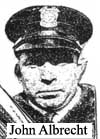 Patrolman John Albrecht, considered a champion police wrestler, races
to the area when he hears Mr. Olson’s cries for help. Officer Albrecht
hones in on Heinbaugh, but misses Harris. This Minneapolis police officer
had heard about the Fischer shooting in St. Paul. He doesn’t know
if Heinbaugh and Harris were the shooters, but he doesn’t wait to
question a man with a revolver. Heinbaugh starts to draw his gun but hesitates
a split second, just long enough for Officer Albrecht to get the upper
hand. They struggle, but Officer Albrecht powerfully slugs Heinbaugh on
the jaw, knocking him unconscious before he could fire his gun. Albrecht
searches Heinbaugh and confiscates his revolver and a pocket-full of loose
cartridges. Harris eludes capture again.
Patrolman John Albrecht, considered a champion police wrestler, races
to the area when he hears Mr. Olson’s cries for help. Officer Albrecht
hones in on Heinbaugh, but misses Harris. This Minneapolis police officer
had heard about the Fischer shooting in St. Paul. He doesn’t know
if Heinbaugh and Harris were the shooters, but he doesn’t wait to
question a man with a revolver. Heinbaugh starts to draw his gun but hesitates
a split second, just long enough for Officer Albrecht to get the upper
hand. They struggle, but Officer Albrecht powerfully slugs Heinbaugh on
the jaw, knocking him unconscious before he could fire his gun. Albrecht
searches Heinbaugh and confiscates his revolver and a pocket-full of loose
cartridges. Harris eludes capture again.
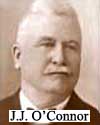 Heinbaugh is taken first to the Minneapolis downtown station where he
confesses to numerous robberies in that city. He is held and booked for
those robberies and the attempted shooting of officer Albrecht. While in
custody, he is transported to Central Station in St. Paul where he is questioned
personally by Chief O’Connor. O’Connor is not happy with the
thought of losing another one of his men. O’Connor himself takes
charge of the search for Harris.
Heinbaugh is taken first to the Minneapolis downtown station where he
confesses to numerous robberies in that city. He is held and booked for
those robberies and the attempted shooting of officer Albrecht. While in
custody, he is transported to Central Station in St. Paul where he is questioned
personally by Chief O’Connor. O’Connor is not happy with the
thought of losing another one of his men. O’Connor himself takes
charge of the search for Harris.
Heinbaugh is taken back to Minneapolis to be held for some time for the assault on Officer Albrecht. Minneapolis detectives continue searching downtown Minneapolis for Harris.
August 12, 1917
St. Paul, Minnesota
Ben regains consciousness. Physicians now believe he will live if there are no unanticipated complications.
Somehow, Harris makes it back across the river again and finds a place to stay in St. Paul: Curry’s rooming house on Spruce Street. He hides out there beneath the police radar for three or four days.
Chief O’Connor sends an all-points bulletin by telephone, telegram, and teletype to police departments far and wide.
August 22, 1917
City Hospital, St. Paul, Minnesota
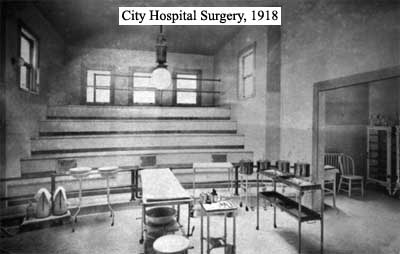 Dr. Albert E. Ahrens takes Ben back into surgery. Using Novocaine as his
only anesthesia, Dr. Ahrens excises the bullet at the tip of the right
mastoid – a hair’s breadth from Ben’s spine – sutures
the incision, and applies a sterile dressing.
Dr. Albert E. Ahrens takes Ben back into surgery. Using Novocaine as his
only anesthesia, Dr. Ahrens excises the bullet at the tip of the right
mastoid – a hair’s breadth from Ben’s spine – sutures
the incision, and applies a sterile dressing.
August 23, 1917
Chicago Police Department, Chicago, Illinois
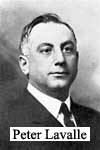 Harris is caught and arrested for carrying concealed weapons. Chicago
police tentatively identify him as being the person described in J.J. O’Connor’s
communication sent several days previously. They telegraph St. Paul police
who confirm Harris’s identity. Harris waives extradition. O’Connor – known
as “the big fellow” – smiles with satisfaction when he
announces to the press that Harris is in custody in Chicago. St. Paul detective
Peter Lavalle departs immediately by train for Chicago to bring Harris
back to justice in St. Paul. They return a few days later. Harris is locked
in a cell in the Ramsey County jail on August 26.
Harris is caught and arrested for carrying concealed weapons. Chicago
police tentatively identify him as being the person described in J.J. O’Connor’s
communication sent several days previously. They telegraph St. Paul police
who confirm Harris’s identity. Harris waives extradition. O’Connor – known
as “the big fellow” – smiles with satisfaction when he
announces to the press that Harris is in custody in Chicago. St. Paul detective
Peter Lavalle departs immediately by train for Chicago to bring Harris
back to justice in St. Paul. They return a few days later. Harris is locked
in a cell in the Ramsey County jail on August 26.
August 29, 1917
St. Paul
After 18 days in the hospital, Ben is discharged and returns home. His right arm is paralyzed.

